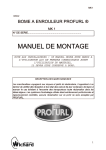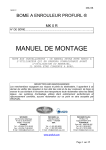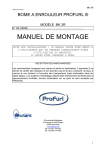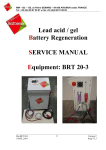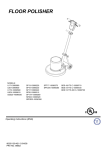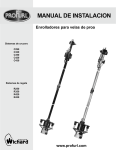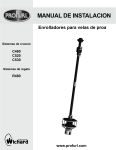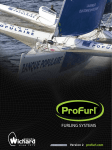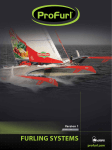Download in-boom mainsail reefing
Transcript
MK 1 Congratulations for the purchase of your PROFURL in-boom reefing furling system. Please read carefully this manual. It will give you to all information for fitting and using your system in order to give you many years of dependable service. IMPORTANT WARNING FOR USING YOUR SYSTEM : ! The PROFURL boom is obviously heavier than your conventional boom. Do not make uncontrolled gibing, specially with strong wind as you could permanently damage your system. Reminder to gibe : 1 - take in or winch your main traveller and main sheet 2 - turn your boat to gibe 3 - gradually release your main traveller and main sheet. You can even better fit a tackle as boom preventer (please see drawing). A boom brake is supplied with your system: it must be used and adjusted at any time. You should not forget to completely release it each time you want to operate your system. 2 MK 1 CONTENTS Page 2 Page 3 Page 4 Page 5 Page 6 Page 6 Page 7 Page 8 Page 8/9 Page 10/11 Page 12 Page 13/14 Page 15 Page 16 Page 17 Page 18 Page 19 Page 20 Page 21 Page 22 Page 23 Page 24/25 Pages 26+ Important warning to use your system Preliminary cautions General description Exploded view Tools needed for fitting Unfitting the hardware from the mast Determining the height of the gooseneck Fitting the slide screws in the mast track. Fitting the gooseneck. Assembling the luff profiles. Fitting the articulation brackets onto the mast / the sheave box. Measuring and fitting the upper luff profile. Fitting the upper luff profile onto the sheave box. Cutting the boom to length Cutting the mandrel to length. Fitting the mandrel onto the boom. Fitting the boom onto the gooseneck. Fitting the boomvang hound / the boomvang. Adjusting the position of mainsheet bails. Installation of the control lines to the cockpit Fitting the mainsail Feeder adjustment. Adjusting the boom angle to the mast. Using the system. Limits for using the system Warranty Spare parts Mainsail design specifications PRELIMINARY CAUTIONS The PROFURL in-boom mainsail reefing system is not designed to be installed on wooden masts, or aluminium masts with track added with screws, rivets, glue or any similar assembly. Fitting on a carbon mast is not recommended an requires special skills. Please contact us. Please check that there is no sign of severe corrosion on the mast which would compromise the strength of the assembly. The person in charge with fitting will be fully responsible for installation and adaptation on board according to the specifications shown in this manual. 3 MK 1 I - GENERAL DESCRIPTION Note : names in bold refer to parts identified on next page The PROFURL in-boom furling system includes : 1. One set of luff profiles (1 and 2) articulated on the aft face of the mast . There are 2 different kinds of luff profiles : one 0.60 m long feeder profile (1) on which the feeder (3) is attached, and several 2 meters long normal luff profiles (2) depending on the mainsail’s luff length. One of these 2 meters long normal luff profiles (2) will be re-cut to length at its upper end to match the expected luff length of the boat. The different luff profiles (1 et 2) are connected to each other by mean of connectors/articulations (4), which are connected to articulation brackets (5) attached on the aft face of the mast. CAUTION : the articulation brackets (5) have a stainless steel pin. Check the difference with end brackets (6), which have Nylon flanges (55). 2. Articulation brackets (5) attached to the mast with 2 slide screws (7) slipped in the mast groove. Every slide screw (7) has a thread and a flat end going through a hole of the articulation brackets (5). The thread of the slide screws (7) receives a washer (33) and locknut (8) for attachment. 3. Connectors/articulations (4) also used to connect the different luff profiles (1 and 2), held by set screws (9). The lower end of the 0.60m long feeder profile (1) will be connected on the gooseneck articulation (10), thus allowing the luff profiles (1 and 2) to rotate together with the boom. 4. A sheave box (11) through which the mainsail halyard is passing. The sheave box (11) will be fit at the top of the luff profiles (1 and 2). It is assembled on the end brackets [2 times (6)], themselves being attached by mean of slide screws (7) and locknuts (8). 5. A gooseneck (12) fit on the mast with 2 slide screws (7), and 2 gooseneck plates (13) cambered at the mast shape before fitting, and which will be riveted onto the mast with the conical head pop rivets (14) supplied. 6. A boom profile(15) which has been delivered either in 4 or 5 meters. It may be re-cut to length when fitting to match the expected boom length. 7. A mandrel (16) which turns on bearings (17 and 18) fit on a bearing holder (19) at the rear end of the boom, and on the drum bearing holder (21) front, turning around a pin inserted in each of the boom end fittings (22 and 23). When re-cutting the boom profile (15) to length, the mandrel (16) should also be re-cut. 8. A drum boom end fitting (22). It includes the drum (21) fit onto the mandrel (16): the drum being loaded with the furling line supplied, by pulling on the furling line and releasing the mainsail halyard it will rotate the mandrel, which will furl the sail. 9. 2 adjustable mainsheet bails (25). More mainsheet bails are optional. 10. A special boomvang (27). It is attached : - onto the mast by mean of a boomvang attachment, including an gooseneck (12) attached onto the mast with 2 slide screws (7) locknuts (8) and 2 gooseneck plates (13) which will be riveted on the mast with pop rivets (14) with conical head supplied. The boomvang lower end will be attached onto an articulation eye (49) rotating in the boomvang gooseneck (56). - onto the boom with a boomvang hound (28). 11. A ball bearing block (52) to lead the furling line (51) to the cockpit. 12. A boom brake 4 MK 1 5 MK 1 TOOLS NEEDED FOR FITTING In all cases of fitting n A measuring tape n An electric drill n A set of drills n A hack saw with a (new) blade with small teeth n A file n A pencil n A plastic hammer n A 13 mm pipe-wrench n A 19 mm pipe-wrench n A dynamometrical wrench (1daN/m) n 1 set of Allen wrenches (supplied) n 2 clamps with opening 300 mm n Universal pliers n A cutter blade (with new blades) n A large sheet of paper with corners perfectly at 90° and adhesive tape n Several small plywood or rubber shims. n A pop rivet gun for 5 mm stainless steel rivets. Note : the plates to fit the gooseneck and boomvang attachment are 8 mm thick and made out of aluminium. A convenient hydraulic or mechanical press should be used to bend them at the mast shape, fitting them on the mast with the clamps. If the fitting is made on a standing mast n A Boson’s chair n Some short ropes of 8 or 10 mm diameter. II - PREPARATION II.1 - UNFITTING THE HARDWARE FROM THE MAST II 1 a - Dismantle the original gooseneck, as well as cleats, winches and winches brackets on the mast, as well as any piece of equipment which would interfere with the fitting of the new gooseneck and with the ability for the forward boom end fitting to rotate when the boom should swing from one side to the other. Please see § III 1 b and drawing 1 for dimensions of the new gooseneck in relation with mark « C » on the mast. II 1 b - The original boomvang attachment should not be used, as the axis of rotation of the boom and of the new gooseneck need to be in line, which would never be the case with the original boomvang fitting. II 1 c - Dismantle the original feeder (if any) at the mast track entrance. II 1 d -Check that the slide screws (7) supplied have suitable dimensions for the mast track. If not, their width should be modified (turned, machined, grinned, filed) accordingly. SLIDE SCREWS Width may be reduced if necessary In all other cases please contact us. 6 MK 1 III - INSTALLATION III 1 - DETERMINING THE HEIGHT OF THE GOOSENECK III 1 a -To avoid any potential conflict between the boom and the cabin top, a bimini, a lifeline or any other piece of equipment, please accurately mark the level of the lower edge of the original boom. Please see drawing 1. III 1 b - Check that the boomvang delivered with your system will make once installed an angle of minimum 30° with the mast and the boom. Should it not be the case, the position of the new gooseneck must be fit higher on the mast in order to obtain this minimum 30°angle. Information: pin to pin boomvang length : 1400 mm open / 1305 mm closed III 1 c - Draw a line « C » on the mast at the level of the lower edge of the original boom. Please see drawing 1. III 1 d -Draw a line « B »on the mast at 364mm (1’ 2 21/64”) above line « C ».The line « B » will correspond to the level of the upper edge of the gooseneck plates (13) once fit on the mast. Drawing 1 III 2 - FITTING THE SLIDE SCREWS INTO THE MAST TRACK III 2 a - Insert the head of the slide screws (7) into the mast track. The number of slide screws you need to insert depends on the number of articulation brackets : A - two slide screws are needed for the boomvang attachment. Slide these slide screws down to the mast foot to later fit the boomvang attachment (§ III 11, and drawing 13). B - Slide four slide screws (7) into the mast track for the upper end brackets (6). C - Slide as many times two slide screws (7) into the mast track as the quantity of articulation brackets (5) to be fit. Please see drawing 5. III 2 b - Move the stacked slide screws mentioned in above B and C upwards onto the mast above the mast track opening, and temporarily hold them with adhesive tape to prevent them slipping out of the track. III 2 c - Slide 2 extra slide screws (7) into the mast track for fitting the gooseneck. 7 MK 1 III 3 - FITTING THE GOOSENECK III 3 a - Attach the gooseneck (12) to the mast track at the convenient height (§ III 1) with the 2 corresponding slide screws (see § III 2 c) and corresponding locknuts (8). Tightening torque must be 1 to 1.5 daN/m. Please see drawing 4. III 3 b - Bend the aluminium gooseneck sideplates (13) with the clamps to accurately camber them to the mast shape. During bending please protect the plates from dings and dents. III 3 c - Screw the sideplates (13) onto the gooseneck. Would the sideplates be too long, they can be re-cut if necessary, keeping in mind too much length is always better than too little. III 3 d - Draw lead lines for drilling on the side plates (13). Press the side plates on the mast with clamps ( please protect the plates with convenient means). Drill at Ø 5 mm and machine holes so that the conical heads of the pop rivets (14) will be flush with the surface of the side plates. There should have at least 12 pop rivets (14) on each side plate (13). III 3 e – Fit the Nylon washer 29a onto the vertical gooseneck pin. Temporarily fit the gooseneck articulation (10) onto the gooseneck (12) as well as Nylon (29) and stainless steel (30) washers and tighten the low aspect nut (31) and Nylock (30a). III 4 - ASSEMBLING THE LUFF PROFILES Fitting at this stage will be easier flat on the ground. III 4 a - Fit the luff profiles (1 et 2) together starting with the feeder profile (1) where the feeder (3) is attached to. The lower end of this feeder profile can be identified by the luff grooves have been machined off . Please see drawing 2. Drawing 2 Drawing 3 III 4 b - Completely insert a connector/articulation (4) at the upper end of the feeder profile (1) so that the Nylon bushing is turned towards the lower end of the feeder profile. Please see drawing 4. III 4 c - Fit and tighten the set screws (9) at the upper end of the feeder profile. III 4 d - Fit a 2 meter long normal luff profile (2) onto the connector/articulation (4) which has been fit as above. Caution :check again that the collars of the Nylon bushings (57) of the connectors/articulations (4) are turned towards the lower end of the luff profiles column. 8 MK 1 III 4 e - Fit and tighten the set screws (9) onto the luff profiles. Fit with the same method all the luff profiles (2) except the last 2 meter normal profile. Please see drawing 7. III 4 f -Hoist the above luff profiles column from the aft side of the mast by preferably using the existing topping lift. Caution: during hoisting check that the luff profiles are kept as straight as possible by pulling from the bottom end of the luff profiles. III 4 g - Completely insert the lower end of the feeder profile (1) into the striped aluminium connector of the gooseneck articulation (10) . Please see drawing 4. Drawing 4 III 4 h - Climb the mast taking with you : • the two end brackets (6). Please see drawing 6 • all the articulation brackets (5). Please see drawing 5 • the sheave box (11). Please see drawing 6 • all the slide screws (7) to be slipped upwards in the mast track, and locknuts (8). 9 MK 1 III 5 - FITTING THE ARTICULATIONS BRACKETS ONTO THE MAST III 5 a - Consider the 2 lower slide screws (7) stacked above mast track entrance. III 5 b - Fit an articulation bracket (5) onto these slide screws with the stainless steel pin pointing upwards (please see drawing 5), and completely insert the Nylon bushing of the connector/articulation onto the stainless steel pin. III 5 c - Fit washers (33) and locknuts (8) onto the thread of the slide screws (7). Tightening torque should be 1 to 1,5 daN/m. Caution : during fitting the articulation brackets (5) onto the connector/articulations (4), permanently check that the feeder profile is indeed fully inserted into the gooseneck articulation (10). Please see drawing 4 III 5 d - Fit all the articulation brackets (4) with the same procedure. Drawing 5 III 6 - FITTING THE SHEAVE BOX III 6 a - Slide up in the mast track the 4 remaining slide screws (7). III 6 b - Temporarily fit the 2 end brackets (6) and the sheave box (11) so that the rear upper end of the sheave box leaves a minimum clearance of 20 mm with the backstay(s). Please see drawing 7. Drawing 6 10 MK 1 III 6 c - Draw a line « A » on the mast corresponding to the position shown on drawings 7 and 8. Drawing 7 11 MK 1 III 7 - MEASURING AND FITTING THE UPPER (CUT) LUFF PROFILE III 7 a - Accurately measure the length« A to D ». Please see drawing 8. III 7 b - Mark length “ A” to “D “ on the remaining luff profile (2) and cut it at this exact length. File smooth the cut edge . Note: in case of a very flexible mast, or fractional rig, cut profile at “A” to “D” minus 15 mm, and leave the 15 mm as a play between the cut edge of the profile and “A”. III 7 c - Fit without tightening the 2 set screws (9) on the threads located at the opposite side of the cut end. III 7 d - Hoist the cut luff profile (2). Drawing 8 III 8 - FITTING THE UPPER (CUT) LUFF PROFILE ONTO THE SHEAVE BOX III 8 a - Slightly ease the 4 slide screws (7) which hold the upper end brackets (6) and remove the sheave box (11). III 8 b - Insert the striped aluminium bar of the sheave box (11) into the cut end of the luff profile (2). Note: in case of a very flexible mast, or fractional rig, leave 15 mm play between the top end of the profile and “A”. III 8 c - Insert the bottom end of the luff profile (2) into the uppermost connector/articulation (4). III 8 d - Fit again the sheave box (11) onto/between both end brackets (6) and fasten the 4 slides screws (7) to permanently secure this assembly. III 8 e - Tighten the set screws (9) at the bottom end of the cut luff profile (2). III 8 f - Follow the path for the mainsail halyard as shown on drawing 7. 12 MK 1 III 9 - CUTTING THE BOOM PROFILE AND THE MANDREL TO LENGTH III 9 a -HOW TO CALCULATE THE LENGTH OF THE BOOM PROFILE . Case # 1: The PROFURL boom overall length should be the same as the one of the original boom. Case # 2: The PROFURL boom being delivered in over length, the opportunity may be taken to make the boom longer. Caution : changing the boom length could affect the balance at the helm when sailing under sails. In this case check that the aft end of the boom cannot touch the backstay or any other piece of equipment on board. In both cases please refer to drawing 9 for dimensions. Drawing 9 The PROFURL in-boom reefing system is delivered pre-assembled and in over-length. The boom profile (15) and the mandrel (16) will probably have to be re-cut to length to match the boat’s requirements when fitting the system. CAUTION : should the complete length of the boom profile be used, the rear boom end fitting is just temporarily attached to the boom profile for shipping. Please follow the fitting procedure from § III 9 c 7 and on, as if the boom profile had been re-cut. III 9 a 1 - To cut the boom profile (15) and the mandrel (16) to length, first dismantle the rear boom end fitting (23) from the boom profile and pull out the mandrel (16) from the boom profile. Caution : during dismantling, the mandrel (16) will not be held any more. Please keep control about the mandrel potentially falling down when pulled backwards. Also mind not to lose the washer (20) located forward of the drum (24) . 13 MK 1 III 9 a 2 - To re-cut the boom profile (15) to length, and to make sure that the cut section is accurately perpendicular to the profile, wrap a sheet of paper or mylar (with accurate right angle corners) so that the edges are in perfect line, and attach it with adhesive tape. Please see drawing 10. Draw a line on the boom profile, following the edge of the sheet where the boom profile will be cut. III 9 a 3 - Cut the boom profile according to the line and file edge smooth. Drawing 10 14 MK 1 III 9 b -CUTTING THE MANDREL TO LENGTH The mandrel (16) should be re-cut by exactly the same amount as the one having been cut off from the boom profile. (Example: if you have re-cut 312 mm from the boom profile, you should also re-cut 312 mm from the mandrel) III 9 b 1 - Remove the bearing holder (19)+bearing (18) assembly from the rear end of the mandrel (16). III 9 b 2 - Cut the mandrel (16) at its rear end with the same procedure as the one having been used for cutting the boom profile (15), same as § III 9 a 2. File smooth the rear (cut) end of the mandrel and foot track ends. Caution : the forward (drum) end of the mandrel (16) must not be cut ! III 9 b 3 - Fit again the bearing (18) and bearing holder (19) into the cut/rear end of the mandrel. Tap a thread at M6 (6mm) at opposite from the grooves at 25 mm (1”) from the cut end. Fit and tighten screw (38). III 9 b 4 - In case the mandrel has been cut a little too short, the fore and aft play must be reduced to a minimum. To do this, loosen the screw (38), push the mandrel forward, pull out the bearing holder (19) so that the washer (20) touches backwards, tighten again screw (38). III 9 c - FITTING THE MANDREL ONTO THE BOOM III 9 c 1 - Before fitting the mandrel (16) into the boom profile (15) turn the boom upside down to fit the gooseneck articulation (10) onto the drum boom end fitting (22) with the pin (34) and open the split pin (35). III 9 c 2 - Fit the mandrel (16) into the boom profile (15), fit the washer (20) and the drum bearing (18) onto the stainless steel pin (36) inserted in the drum boom end fitting (23). III 9 c 3 - Check that the mainsheet bails (25) and boomvang hound (28) are properly fit in the bottom track of the boom as shown on drawing 11. III 9 c 4 - Slide the bearing (18) located at the rear end of the mandrel (16) onto the stainless steel pin inserted in the rear boom end fitting (23). III 9 c 5 - Completely insert the rear boom end fitting over the rear (cut) end of the boom profile (15). Tip :A ratchet tie down strap is a handy tool to do this. III 9 c 6 - Drill holes ∅ 5mm at the rear end of the boom profile (15) through the predrilled holes of the rear boom end fitting (23). Fit the corresponding flat head pop rivets (24) supplied in these holes to permanently attach the boom end fitting onto the boom profile. Drawing 11 15 MK 1 III 10 - FITTING THE BOOM ONTO THE GOOSENECK III 10 a - Hoist the boom with a halyard and a topping lift (drawing 12) by keeping it as horizontal as possible. Pull it backwards at the same time. III 10 b - Slide from underneath all together ( same as § III 3 e) : 1. the vertical aluminium striped bar of the gooseneck articulation (10) into the bottom end of the feeder profile (1). 2. the vertical stainless steel pin of the gooseneck articulation (10) into the corresponding vertical hole of the gooseneck fitting (12). III 10 c - Fit the nylon washer (29a) onto the vertical stainless steel pin (10). Insert vertical pin into the gooseneck fitting (12). Fit stainless steel washer (29) on the thread. Permanently fit and tighten with a 19 mm tube or ratchet wrench onto the thread the low aspect locknut (31) and Nylock (30a). Fit the plastic cap over the Nylock. Caution : do not drop or raise the boom more than 15° from horizontal position as it could cause permanent damage to the gooseneck. From this stage and on the luff profiles must turn together with the boom. Drawing 12 16 MK 1 III 11 - FITTING THE BOOMVANG HOUND AND THE BOOMVANG Reminder: the ideal working angle of the boomvang being 45° the boomvang must not angle less than 30 ° with the mast or boom. III 11 a - Fit the boomvang attachment fitting (56) with the two slide screws which had been stored at the mast foot (§ III 2 B). III 11 b - Bend the aluminium gooseneck sideplates (13) with clamps to accurately camber them to the mast shape. During bending please protect the plates from dings and dents. III 11 c - Would the sideplates be too long, they can be re-cut if necessary, keeping in mind too much length is always better than too little. III 11 d - Draw lead lines for drilling on the side plates (13). Drill at Ø 5 mm and machine holes so that the conical heads of the pop rivets (14) will be flush with the surface of the side plates . There should have at least 12 pop rivets (14) on each side plate. III 11 e - Fit the stickers (33) onto the plates to hide the head of the pop rivets. Do the same for the gooseneck plates ( please see § III 3 e). III 11 f - Fit Nylon washer (29) onto the pin of the articulation eye (49). Fit pin into the gooseneck attachment, fit the washers (30 and 29a) and locknuts (31 and 30a). III 11 g - Fit the boomvang onto the articulation eye (49) and onto the boomvang hound (28). Fit the pins and the split pins. Drawing 13 You can now release the topping lift. 17 MK 1 III 12 - ADJUSTING THE POSITION OF THE MAINSHEET BAILS III 12 a - Adjust the position of the mainsheet bails (25) with the set screws which can be reached from underneath. Fasten the mainsheet blocks on the mainsheet bails. CAUTION : on boats with a mainsail track or mainsail block attachment on deck ahead of the main hatch the mainsheet bails (25) must be re-positioned as far backward as possible. III 12 b - Push the boom by hand over the lifelines as far as possible and tie a knot on the mainsheet so that in no case the boom profile can be damaged by the rearmost shrouds when running downwind or jibing. III 13 - INSTALLATION OF THE CONTROL LINES TO THE COCKPIT REMINDER TO AVOID FRICTION 1. Only use good quality ball bearing blocks, which will have to be cleaned and lubricated from time to time as per manufacturer’s specifications. 2. Use ball bearing blocks with a sheave of large diameter. 3. Reduce as much as possible the number of lead blocks between the drum and the cockpit. 4. Reduce as much as possible the angle of deviation of the control lines. III 13 a - Attach the ball bearing block supplied at the mast foot on starboard at the convenient position to lead the line into the middle of the drum at 90° angle . III 13 b - Pass the furling line supplied from underneath through the block, then through the hole of the drum’s shaft and a tie small knot at its end so that the knot will be completely hidden inside the drum’s shaft. (Please see drawing 14). Drawing 14 III 13 c - To fill the drum with line turn the mandrel (16) by hand towards port side (seen from above) so that the furling line exits from the drum on the starboard side. III 13 d - Fit another ball bearing block at the mast foot to lead the mainsail halyard to the cockpit. Remind to use the right type and dimensions of blocks. III 13 e - Check that the exit from the mast of the mainsail halyard does not bring too much chafe. 18 MK 1 IV - FITTING THE MAINSAIL ⇒ Please check again that the foot tracks have been filed smooth at the rear (cut) end before starting inserting the foot tape of the sail. CAUTION : before operating the PROFURL in-boom reefing system please make sure that : 1) the mainsail construction and design are in accordance with the attached specifications. Please refer to the attached mainsail design specification. 2) the boomvang angle adjustment ( please see § VI ) is correct. This adjustment is an essential point to get a good quality furling of the mainsail as well as ease of operation. IV 1 - Turn the mandrel (16) by hand so that the tracks (please see drawing 15) are upwards. IV 2 - Do not yet insert the mainsail battens into the batten pockets. IV 3 - Insert the tack slide (48) into the tack webbing with the flat part backwards and lock the webbing ahead of the two small plastic cylinders. Drawing 15 IV 4 - Insert the webbing with the tack slide into the port side foot track. Please see drawing 15. IV 5 - Insert the bolt rope foot tape into the same port side track and gently pull the sail forward. IV 6 - Once almost at the fore end insert the clew slide (49) into the clew webbing so that the webbing is locked between the two small plastic cylinders of the clew slide (48), and insert the clew slide into the groove of the mandrel (16). Pleas see drawing 16. IV 7 - Lock the flat part of the tack slide into the machining of the mandrel groove and pull the sail backwards to lock. Please see drawing 15 Drawing 16 19 MK 1 IV 8 - Slide the clew pin (50) with the ring upwards into the foot track ends (16). Please see drawing 16. IV 9 - Lash a line between the clew webbing and the ring of the clew pin (50) and tension the foot of the sail. Check to tie or cut any loose extra length of lashing line. IV 10 - Insert the battens into the batten pockets. IV 11 - Attach the halyard onto the head of the mainsail. IV 12 - Unscrew by about 3 turns only the port side plastic knob (46) of the feeder (3) to increase the gap between the bronze rollers (40). IV 13 – Insert the « continuous » port side luff tape between the bronze rollers of the feeder and hoist by hand only a few centimetres of sail. IV 14 -. Slide the starboard side « head » luff tape into the starboard luff groove. Luff entry for this starboard luff tape is located just above the feeder (3) at the connector level. V - FEEDER ADJUSTMENT The feeder has features allowing : * to very accurately trim the gap between the 2 bronze rollers (40) to exactly match the bolt rope diameter. * to quickly increase the gap between the bronze rollers to easily insert the bolt rope/luff tape into the groove of the luff profiles after the sail has been furled or removed. * to instant bring back the correct gap for feeding the sail into the groove of the luff profile to use the system . V 1 - ADJUSTMENT OF THE GAP BETWEEN THE ROLLERS (PLEASE SEE DRAWING 17) V 1 a – Completely screw by hand but do not over tighten the port side knob (46) of the feeder. V 1 b – Release screw (63). V 1 c - Adjust the starboard side plastic screw (41) with the adjustment tool (67) inserted into the holes of the screw’s flat head, till feeling that the luff tape in pinched. Then unscrew it back by about ¼ of turn to make the luff tape free to slide up and down. The adjustment is now correct. Lock again screw 63. V 1 d - Hoist the sail by gently pulling on the halyard. V 1 e - To lower or furl the sail, release the halyard. Drawing 17 20 MK 1 V 2 - TO INSERT THE BOLT ROPE INTO THE FEEDER V 2 a - Unscrew the port side plastic knob (46) by a few turns to increase the gap between the bronze rollers (40). V 2 b - Insert the bolt rope/luff tape between the 2 bronze rollers (40) and push it upwards into the port side luff track. V 2 c - Completely tighten by hand without over-tightening the port side plastic knob (46). V 2 d - Insert the starboard side bolt rope/luff tape directly into the starboard luff track above the feeder (Please see drawing 18). V 2 e - The mainsail is now ready to be hoisted. Drawing 18 VI - ADJUSTMENT OF THE BOOMVANG ANGLE TO THE MAST This essential procedure must be achieved either with no wind at all, or with extremely calm wind and the boat heading into the wind. VI 1 - Hoist the sail as previously described and tension the halyard normally. VI 2 - Completely loosen the nuts of the boomvang hound (28) , and make sure the hound is totally free to move fore and aft. VI 3 - Make sure the mainsheet is completely loose and let the boom hang in this position. VI 4 - Re-tighten the nuts of the boomvang hound (28) with the boom in this position. VI 5 -The sail can now be furled by gently releasing the halyard and pulling together on the furling line. VI 6 - Fine tuning of the boomvang position adjustment may be necessary : 1. If the luff tape rolls too much backwards, adjust the boomvang hound (28) position so that the boom angles up a little more. 2. If the luff tape rolls too much forward, adjust the boomvang hound position so that the boom angles down a little more. 21 MK 1 VII - USING THE PROFURL IN-BOOM REEFING SYSTEM IMPORTANT WARNING : when gibing please keep constant control of the boom with the mainsheet. The boom brake supplied with the system must be adjusted and used at any time as per manufacturer’s specifications. It should be released each time you want to operate your system. Rules of thumb : 1. Make the boat‘s angle with the wind corresponding to a broad reaching or closer to the wind. 2. Before using the system completely release the mainsheet so that the boomvang push effect brings back the angle between the boom and the mast to its « operating » position. 3. If the mainsail is not properly do not attempt to correct this immediately, but hoist the sail completely, check points as per § VI 6 and try again. After a short period of time you will feel how much drag is to be given to the halyard to get the right tension to obtain a smooth furling of the sail. During hoisting the sail a slight drag should be applied to the furling line in order to allow the furling line to be rolled tight enough in the drum : this will make next furling easier. Should you wish to just a reef your sail, please carefully check that the head of the sail is just above a connector/articulation in order to prevent the luff profile to sag too much. Please stick insignia reefing marks on the luff of the sail which will be at feeder level to show when the head is at the convenient position. When in harbor, or sailing under power, please remove the halyard from the head of the mainsail, attach it onto the rear end of the boom and tension it. VIII - LIMITS FOR USING THE SYSTEM IN RELATION WITH APPARENT WIND Some boats have spreaders at 90° from boat’s centreline, some other have spreaders angling backwards. Some other have aft shrouds. In these last cases the sail will drag on the standing rigging earlier than with boats having spreaders at 90°. This means that the sailcloth will touch the standing rigging sooner or later depending on each boat. A smooth operation is obtained as long as the sail is not touching any shroud or spreader when the mainsheet is completely released. In other terms it is necessary to come into the wind to reef or furl the sail just as you would have done with conventional mainsail reefing. However in case of emergency the sail can be rolled at larger angles to the wind till the stage when the friction on the standing rigging will make the system more and more difficult to operate. Friction would also obviously increase with the wind’s speed. In this case a smooth furling can’t be guaranteed. 22 MK 1 WARRANTY 1- The PROFURL in-boom reefing system is warranted for 3 years from date of purchase against parts and materials, provided the warranty card is returned within fifteen days from date of purchase. The warranty covers the original owner and is not transferable. 2 -The warranty is limited to the repair and replacement of defective parts only by an authorised PROFURL dealer and only after the written consent of PROFURL France or PROFURL USA . 3 - This warranty covers only the PROFURL parts and materials. Any accidental damages or expenses are not covered. 4 - This warranty is void if the system is modified or repaired without prior written notification to PROFURL France/USA. 5 - This warranty does not cover damages caused by systems which has not been properly installed. 6 - This warranty does not cover the misfunctionning of the system due to a sail having been made without strictly following the attached specifications. - 7 - After installation the customer should check the following : the sail dimensions are accurately adapted to the system’s dimensions. the sail has been designed and made according to the attached specifications. all screws are properly tightened. the various fitting procedures and adjustments described in this manual are strictly followed. "---------------------------------------------------------------------------------------------------------------------------------------------- Please return this portion within 15 days of purchase to : PROFURL Z.I. des Marais 32 rue des Osiers 78310 - COIGNIERES France Owner’s name :............................................................. Date of purchase :............................................................. Boat’s type............................................................. Boat’s length....................................................... Boat’s displacement.................................................. Mainsail’s luff length................................ Mainsail’s foot length................................. Installed by....................................................... Date………………………………………………………………..Owner’s signature : 23 MK1 SPARE PARTS MK 1 24 MK1 SPARE PARTS LIST Part # Designation MK 1 Part # Designation P 177033 P 177036 P177037 P177040 P177112 50468 50495 P177038 P177039 P177032 02225 P177034 P177042 50493 00052 P177041 50466 50677 P177038 P177039 P177031 50453 P177035 50451 50445 50579 50446 50504 50942 50886 P177020 50463 P177045 50456 50486 50546 P177038 P177039 00018 02302 P177021 P177022 50901 50903 51065 50011 00095 50940 00094 50489 P177023 P177011 50427 50977 50465 50696 50698 P177004 P177011 P177024 P177130 Complete sheave box Sheave box only Sheave Sheave pin and slit pin End bracket End bracket only Bushing for connector/articulation Slide screw for rectangular track and locknut Slide screw for round track and locknut Complete luff profile Luff profile only Complete connector / articulation Connector only Bushing for connector/articulation Set screw ST HC M6X6 Articulation bracket Articulation bracket only O-ring φ 4.9 x 1.9 Slide screw for rectangular track and locknut Slide screw for round track and locknut Complete feeder profile Feeder profile only Complete feeder Feeder housing Feeder rollers adjustment screw (starboard side) Feeder rollers adjustment knob (port side) Feeder roller Pop rivet 4 X 13,5 TR PE screw M6 x 6 Adjustment feeder tool Complete gooseneck Gooseneck or boomvang attachment only Kit sideplates + screw and pop rivets + stickers Gooseneck or boomvang sideplates Pop rivets 4,8 X 16 TF Stickers Slide screw for rectangular track and locknut Slide screw for round track and locknut Locknut M8 SS washer 08 Complete gooseneck articulation Complete lower ending bearing holders Gooseneck articulation only Vertical pin Large PE pin washer Small PE pin washer SS washer 12 Low aspect nut H - M12 Locknut H - M12 Locknut cap Gooseneck pin with split pin Drum boom end fitting with pin Drum boom end fitting only Spacer steel Assembling pin for drum boom end fitting Pop rivets 4,8 X 20 TR Pop rivets 4,8 X 25 TR Complete boom profile 4m Drum boom end fitting with pin Mainsheet bail Complete boomvang hound 50360 50344 50713 P51235 Ball bearing block 8 mm ((5/16'') furling line Recommended operating procedure (13' 1 1/2'') boom brake" 203 C model " 50511 50483 02346 50830 P177012 P177005 P177011 Boom profile 4 m (13' 1 1/2'') Mandrel for 4 m (13' 1 1/2'') boom Set screw STHc Tube 1/2" for rainwater catching Drum only Complete boom profile 5m Drum boom end fitting with pin Part # P177100 P177043 P177130 50444 50657 00018 P177024 Mainsheet bail P177130 50538 Complete boomvang hound Boom profile 5 m (16' 4 3/4'') 50540 Mandrel for 5 m (16' 4 3/4'') boom 02346 50830 P177012 P177014 50460 50462 Set screw STHc Tube 1/2" for rainwater catching Drum only Drum bushing and washer Drum bushing Washer LN 16 Part # P181210 P177038 P177039 Designation Boomvang attachment Slide screw for rectangular track and locknut Slide screw for round track and locknut 02346 P177018 50603 P177015 Set screw STHc M8 x 8 Rear boom end fitting with pin and pop rivets Pop rivets 4,8 X 14 TR Rear bushing kit 50463 50456 50486 50546 Boomvang attachment only or gooseneck Boomvang or gooseneck attachment sideplates Pop rivet 4,8X16 TF Stickers 50461 Bearing holder P181211 Complete articulation 50455 50462 P177016 P177017 P177019 P177024 02346 01659 Rear bushing Washer LN 16 Tack slide Clew slide Clew pin Mainsheet bail Set screw STHc M8 x 8 Mainsheet bail only 50803 51065 50011 00095 50940 00094 50489 Articulation eye Large PE pin washer Small PE pin washer SS washer 12 Low aspect nut H - M12 Locknut H - M12 Locknut cap BOOMVANG AND ACCESSORIES Designation Complete boomvang Bommvang attachment pin Complete boomvang hound Boomvang hound SS washer 08 Locknut H - M8 BOOMVANG ATTACHEMENT 25 MK 1 IN-BOOM MAINSAIL REEFING-FURLING SYSTEM MK 1 MAINSAIL DESIGN SPECIFICATIONS 1. GEOMETRY The design of the mainsail is very critical to the proper operation of the ProFurl In-Boom Reefing Furling system. General design requires a slightly flatter sail than normal with a minimum luff curve built into the sail to ensure proper rolling of the sail onto the furling mandrel and into the boom cavity. a)Luff curve design: A straight luff is by far the most optimal for rolling the sail but not necessarily the best for sail shape. To compensate for various rig designs and mast prebend, a maximum of 2 inches of luff curve may be designed into the mainsail. Further draft must be built into the sail through the broad seams. Caution : if the 2 inches luff curve is exceeded it is possible the sail will not roll properly into the boom cavity. b) Draft: As with any furling sail, the draft of the mainsail must be flatter than with a conventional mainsail. Leach broad seaming should remain normal with primary changes to the luff broad seams. A maximum draft of 8% may be used on a standard furling mainsail. This design will offer the most optimal sail shape for reefing and furling the mainsail. If a deeper draft is desired for better light air performance, a sail shaping item such as foam pad must be added to the foot of the sail. The foam pad is designed into the foot of the sail under the same theory as a foam pad is added to the luff of a reefing-furling headsail. Shape of the foam pad will be determined by the depth and position of the mainsail draft. Caution : Increasing the draft above 8% may create a less desirable sail shape when reefing the mainsail. c) Tack angle and foot curve: The tack angle based on a straight luff and foot must be cut at 88°. Minimum foot curve should not exceed 0.5% of the foot length at mid-length of the foot. Please refer to drawing #1. The finished foot of the sail should be a bolt rope with a finished diameter of 8 mm (5/16”). d) Roach: Maximum positive leach curve should not exceed 6% of the leach length. If a fuller roach is desired additional reinforcement will be necessary at the forward end of the batten pockets and may not allow the luff of the sail to set properly in light air. Also, the added load on the battens may accelerate luff tape wear. 26 MK 1 2. Battens a) Number and type of battens: 4 semi full length battens are recommended. Additional battens may be added, but keep in mind that additional battens create more bulk to the sail and will limit the ability to furl max luff length into the boom cavity. Semi flat tapered battens may be used if desired, but may also add additional bulk to the sail. b) Batten pocket positions: Batten pockets should be sewn on the port side of the sail and be of standard design based on the type of battens being used. Reinforcement of the batten pocket at the luff must not be closer than 33 mm (1 5/16”) to the leading edge of the luff tape (see drawing #2). Leach end of the batten pockets may be finished in the sailmakers preferred style. Please refer to drawing #1 for batten pocket angles. Note: batten pocket angles are based on a straight luff curve. 3. HEAD, TACK AND CLEW ASSEMBLY Only webbing straps of 25 mm (1”) and a two ply maximum thickness of 3 mm (7/64”) should be used at the tack and clew of the sail. Metal grommets should not be utilized as they will not allow the sail to furl properly and may damage the reefing-furling system. Please refer to drawings #3, #4 and #5 for specific detail. 4. LUFF TAPE ASSEMBLY a) Primary luff tape: Teflon luff tape with a finished diameter of 5 mm (3/16”) is recommended for the luff of the sail. Attachment of the luff tape should be performed with the sails final luff curve. Luff tape should have only one seam immediately aft of the bolt rope and fit to the sail with the bolt rope immediately aft of the bolt rope and fit to the sail with the bolt rope against the cut luff curve of the sail. Caution : Luff tape applied to a sail based on a luff curve drawn onto the sail may shorten the life expectancy of the luff tape. Also luff tape with a secondary seam aft of the primary bolt rope seam may require replacement sooner than the recommended type. b) Secondary luff tape at head: In order to better distribute the potentially high leach loads induced into the head of the sail a secondary luff tape is sewn onto the starboard side of the sail. The secondary luff tape should be between 200 mm and 500 mm (8” and 20”). Seaming of the secondary luff tape must not be closer than 33 mm (1 5/16”) from the leading edge of the luff tape. Please refer to drawing #6 for further detail. 5. LUFF AND FOOT TAPE DIAMETER a) Primary and secondary luff tape: Maximum finished diameter of 5 mm (3/16”). Teflon luff tape is recommended to minimize friction when hoisting and striking the sail. 27 MK 1 b) Foot tape Maximum finished diameter of 8 mm (5/16”). 6. TACK AND CLEW REINFORCEMENT a) Tack reinforcement: Reinforcement patches at the tack are necessary but should add a minimum amount of bulk to this area of the sail. b) Clew reinforcement: A large primary clew reef patch is recommended. Take a measurement equal to 25% of the foot length, measure from the clew towards the tack & mark the sail at this point. At the 25% mark draw a line parallel to the luff of the sail up to the point where the line intersects the leach. A single layer over this entire area will help reinforce the clew and leach when the sail is reefed. Additional reinforcement in this area is at the discretion of the sailmaker. 7. LEACH REINFORCEMENT AND UV PROTECTION. a) Leach reinforcement The leach of the mainsail should have a secondary strip approximately 2 feet wide sewn onto the starboard side of the sail. This secondary strip will help to strengthen the leach of the sail as well as add additional bulk to the leach. By bulking up the leach of the sail the leach will roll tighter and improve the shape of the reefed sail. b) UV protection: A sacrificial strip, applied to the starboard side of the sail, may serve as dual purpose. First to strengthen the leach and also to protect the rolled mainsail from the elements, if a UV stable material is utilized. By having a sacrificial strip on the starboard side of the leach the need for a formal sail cover is eliminated. Note: The sacrificial UV strip must be wide enough to completely cover the sail when rolled onto a 70 mm ( 2 ¾”) mandrel (tube). 28 MK 1 4 BATTEN MAINSAIL LUFF CURVE DESIGN Drawing 19 29 MK 1 BATTEN MAINSAIL BATTENS ANGLE TO THE LUFF CONSIDERED AS A STRAIGHT LINE Drawing 20 30 MK 1 BATTEN POCKETS CONSTRUCTION Drawing 21 31 MK 1 CLEW Drawing 22 32 MK 1 TACK Drawing 23 33 MK 1 HEAD CONSTRUCTION Drawing 24 34 CONDITIONS DE GARANTIE Sans préjudice de la garantie légale, votre produit PROFURL est garanti 3 (trois) ans à partir de la date de sa mise en service, la facture d’achat au revendeur ou au constructeur faisant foi. La garantie se limite au remplacement ou à la réparation en nos ateliers des pièces reconnues défectueuses. La garantie disparaît immédiatement et complètement si le client modifie ou fait réparer sans l’accord de Wichard le matériel fourni. La réparation, la modification ou le remplacement des pièces pendant la période de garantie ne peuvent avoir pour effet de prolonger le délai de garantie du matériel. La garantie ne couvre pas les dommages consécutifs à un mauvais montage, à une utilisation inappropriée ou abusive, à un accident ou à toute fortune de mer. PROCEDURE A SUIVRE EN CAS D’APPEL EN GARANTIE En cas d’impossibilité de faire constater par une personne compétente la nature des dommages, le client prendra contact directement avec WICHARD S.A. - France. La ou les pièce(s) défectueuse(s) devra (devront) impérativement être retournée(s) pour inspection à WICHARD S.A.S (France), à WICHARD, Inc aux USA ou à WICHARD PACIFIC Pty Ltd, port aux frais du client, dans les 14 (quatorze) jours suivant le constat de l’avarie. En cas de réexpédition du matériel depuis un pays tiers, les frais de dédouanement éventuels correspondant à l’entrée en France ou aux USA restent à la charge du client. Au cas où le client exige une réexpédition des pièces avant réception des pièces défectueuses par WICHARD S.A.S (France), WICHARD Inc (USA) ou WICHARD PACIFIC Pty, celles-ci seront facturées et payables avant l’expédition, règlement par carte bancaire, transfert bancaire ou tout autre moyen. Si la responsabilité de WICHARD est reconnue, WICHARD remboursera le client dans les meilleurs délais. LIMITED WARRANTY Your PROFURL product is warranted for a period of 3 (three) year from the date of purchase against parts and materials. This warranty is limited to the repair and replacement of defective parts by an authorized PROFURL dealer and only after the written consent of WICHARD S.A.S (France), WICHARD Inc, or WICHARD PACIFIC (addresses below). The warranty is void if the system is modified or repaired prior written consent of WICHARD S.A.S (France), WICHARD Inc or WICHARD PACIFIC. This warranty covers only the WICHARD parts and materials. Any accidental damage or expenses are not covered by the warranty. This warranty does not cover damages caused by a system which was installed or used improperly, damaged by collision, or any act of God. In the event of a warranty claim, WICHARD’s liability is limited to the value of the system at the date of purchase. Packaging costs, shipment or custom charges are at customer’s expense. WHICH PROCEDURE SHOULD YOU FOLLOW IN CASE OF WARRANTY CLAIM? • In case it is impossible for the owner to have the damage checked by a skilled person, the owner will contact WICHARD S.A.S (France), WICHARD, Inc (USA) or WICHARD PACIFIC Pty Ltd. Please see address below. • The defective part should be returned at owner’s expenses to WICHARD S.A.S (France), WICHARD Inc or WICHARD PACIFIC Pty Ltd within 14 (fourteen) days after the damage occured to the system. • In case the parts are shipped from a country outside France, USA or Australia, custom duties for return to WICHARD should be prepaid by the owner. • In case the owner will demand urgent replacement of part before the defective part is received by WICHARD, the replacement part will be charged to the owner, and paid before shipping (credit cards accepted). In case WICHARD’s responsibility is finally acknowledged, WICHARD will refund the owner. • No replacement part purchased from a PROFURL dealer will be refunded to the owner. • In the normal warranty procedure, the parts will be returned to the owner, shipping and customs at owner’s expenses. www.profurl.com WICHARD France Hotline / Support technique / SAV 33 rue de l’Etoile du matin 44600 Saint Nazaire, France Tel +33 (0)2 51 76 00 35 Fax +33 (0)2 40 01 40 43 Email : [email protected] WICHARD, Inc 148a Bryce Blvd Fairfax - VT05454 USA Tel : +1 401 683 5055 Fax :+1 802 655 4689 Free toll number: + 1 800 852-7084 Email : [email protected] WICHARD PACIFIC Pty Ltd Unit 13, 2 Bishop Street St Peters NSW 2044, Australia Tel : + 61 2 9516 0677 Fax : + 61 2 9516 0688 Freecall from Australia: 1800 639 767 Email : [email protected]




































